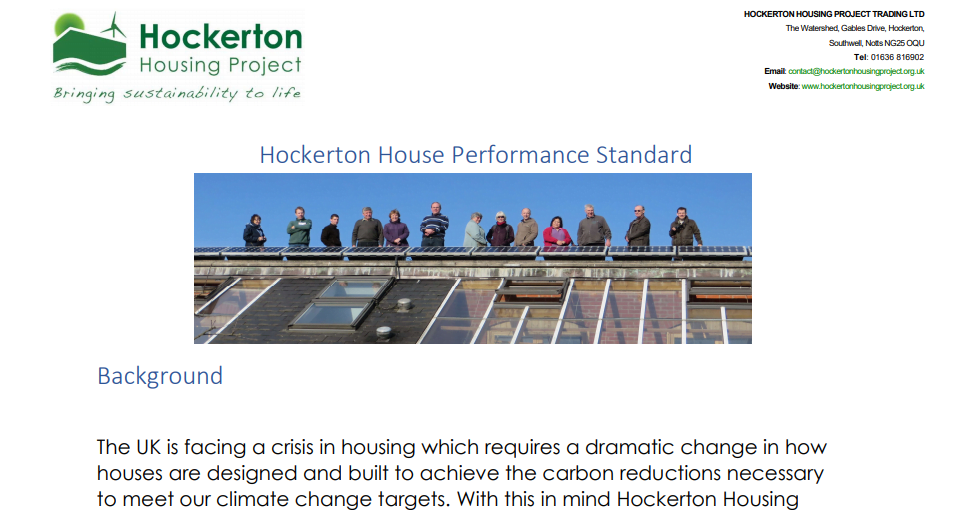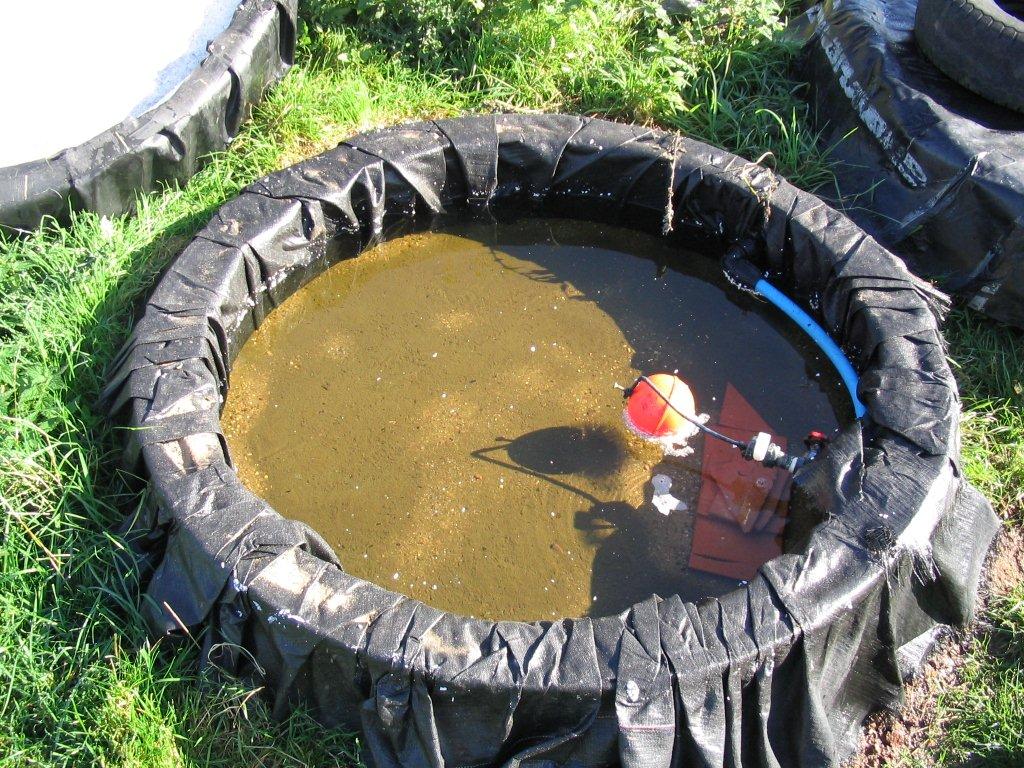Hockerton Housing Project is excited to announce it has released its own housing standard fit for the future world of zero carbon houses. It is called the Hockerton House Performance Standard and outlines the requirements that houses will need to be built to in order to achieve a sustainable low impact world. Unlike the Passivhaus standards these are free to use and go far beyond what Passivhaus can achieve. They are there to inspire!
Minister for Housing Nick Raynsford visiting Hockerton Housing Project

Since the visit of the Minister for Housing Nick Raynsford at our opening we have been pushing the boundaries of construction. Our latest development of nine houses is taking shape with the walls going up in Howgate Close, Eakring with a predicted SAP score of 142! Jerry Harrall is delivery the project and writing Howgate Close, blog.

Howgate close foundations
The UK is facing a crisis in housing which requires a dramatic change in how houses are designed and built to achieve the carbon reductions necessary to meet our climate change targets. With this in mind we are proposing standards of construction to inspire people to construct very high-performance houses factoring in embodied energy and within sustainable communities. The lifestyle of the people living in houses affects emissions of carbon significantly so cannot be ignored. A well-engineered house and designed community space will help inspire them to reduce their carbon emissions. Inspiration can lead to action given the right environment.
The imbedded House Performance Standards are performance based to allow individual designers and builders to create their own solutions. This should encourage creativity and enable future solutions to be incorporated in the finished houses.
These performance standards have been inspired by Dr Robert Vale, Professor Brenda Vale, Mr Nick Martin and the practical experience of the members of Hockerton Housing Project since 1993. They have drawn on General Information Report 53 produced for the Department of Environment Transport and the Regions by the Building Research Energy Conservation Support Unit. More recently the Leti “Net Zero Operational Carbon” targets have pushed us!
There are five subsidiary standards:
- Hockerton-Zero,
- Hockerton-Heat,
- Hockerton-Embodied
- Hockerton-Water,
- Hockerton-Community
Combining these five standards will create houses fit for the future.
If you are a lecturer or student and want to design your own tour find out more here.
How does HHP manage its autonomous water systems at this time of year? As spring arrives, we are planning ahead. We have been pumping rainwater up to our reservoir for the last few months. It is very nearly full at the moment which feels great. We could be going into a dry period so may need it to last quite a long time. We have over 150 days in the waterbody which means self-sufficient living does not feel risky. I am fairly sure it will rain again in the next 5 months!
How many rainwater harvesting systems do we have at HHP? We have three systems one using the reservoir which supplies the bulk of our water, a second one supplying our drinking water and a third more informal system catching water from a shed roof to help supplement watering the plants. Having diverse systems helps you become resilient.
Top Ten Tips for Rainwater Systems
The top ten ways I would suggest to improve a rainwater systems:
- Maintain the collection area so things like gutters are clear and clean. This means you will not lose water when it rains and your filters will have less work to do.
- Keep a record of when you change the filters so that you know when they are due to be done next time.
- Keep an inventory of the stock of filters so you are aware when you need to buy more.
- As mentioned above have more than one system so if one fails you have another water supply to hand.
- Regularly check the level of the store so you know how much water you have and adjust your behaviour should the tank become near empty.
- If you plan to have a drinking water system, consider using concrete tanks instead of plastic tanks for storage as these help reduce the acidity of the water, limit food for bacteria and improve the taste.
- Improve the resilience of your rainwater system by having a large storage tank. The amount you can store enables you to continue to use water between rainfall events. If you believe climate change is going to increase the variability of rainfall, then I would suggest you err on the side of caution and have as large a tank as possible. This will enable you to keep going for as long as possible with your own supply.
- If you want to collect rainwater on a budget, I suggest buying a device that you fit into a standard down pipe that collects the water without any leaves etc. The water collected can be diverted to something as simple as a dustbin or other watertight container. You will supply yourself with a surprising amount of water. There is a local supplier of off the shelf systems called Stormsaver if you want a whole house system.
- If you want to treat a large amount of water that is not for drinking, I suggest a slow sand filter. The name suggests it does not supply enough water but in fact they can. It all depends on the area of the sand and the depth of water above it.
- If you are using a slow sand filter to treat your water be attentive to th

The water from out store is treated through this slow sand filter.
e top 25 millimetres of sand. It is this where the Schmutsdeke lives that does most of the water treatment. When the flow rate reduces you will need to reduce the thickness of this layer but I would suggest only removing about 10 millimetres so there is sufficient left to continue treating the water to some extent when you refill the filter.
Our Rainwater Systems Products
If you want more information, we have chapter written on our water systems which has good clear information and advice. Get chapter 7 here. We also have one on our unique hot water systems chapter 4 and one on the value of autonomy, chapter 12, which you may find useful.
People come on tours to see our systems and we get some good revues.
Subject: Today’s tour!
Dear Debbie, Matthew and Simon,
Thank you so much for the tour today. As always, it was a great way for the students to see and connect many different aspects of the material covered throughout their Environmental Management MSc, and a nice eye-opener for our international students, who are predominantly from India/Pakistan/East and West Africa (some of whom haven’t left their accommodation since they arrived in the UK in January!). Thanks, too for the added XR discussion. Hopefully, there’ll be a few more additions to the XR academy, now!
In other news, we’ve a new MSc course starting in September, on Renewable Energy Management. So it might mean even more attendees next time around, but perhaps by then we may be back in person.
All the best,
Tom
Book your tour here.
This week Kevin McCloud returned to the Hedgehog Project in Brighton on Grand Designs and showed how that housing co-operative has moved on from being an innovative self-build to building roots in the community – reflecting our experience here at Hockerton Housing Project.
We are hoping that the planners at Newark and Sherwood will have been watching, as a plan for a new self-build partnership in Hockerton is now under consideration. The plan is to demolish a redundant industrial building and replace it with five two-storey homes (up to 3 bedrooms) and two one-storey, one bed homes.
Hockerton Housing Project is supportive of the plans for a number of reasons:
- The energy efficient design will deliver 80% less carbon and 60% lower running cost than homes built to today’s minimum standards.
- Each dwelling will have a share in Hockerton’s community-owned wind turbine to ‘offset’ the carbon content of remaining energy use.
- Rainwater harvesting and water efficient appliances will limit demand for mains water, and a reedbed will be used to avoid nasty odours from sewage.
- Affordable housing allows people with a wider range of skills and expertise to live in rural areas.
- The co-operative nature of the development, both in its build and its maintenance, means pride will be taken in the quality of the work on buildings and landscaping.
- The more people resident in the village, the better for local businesses such as the farm shop, the pub, restaurant and ice-cream parlour.
Self-build partnerships are rare, but offer many benefits, so let’s hope the planning officials see the merit of putting brownfield land to better use as a site for new affordable homes in Hockerton, further strengthening the village’s reputation as a hub of innovative and affordable energy efficient homes.
If you are interested in understanding how we developed our self-build at Hockerton Housing Project, and how the co-operative works in practice, make a new year’s resolution to come on one of our Sustainable Living Tours – the next one is 19 January 2013.
HHP has two completely separate autonomous rainwater systems – potable and non-potable. Since the completion of the houses in 1998, water from both systems has been tested regularly.
Our latest results (September 2011) indicate that our drinking water is perhaps cleaner than most branded bottled water! Could it really be that our filtered rainwater can be just as clean as the commercial products that line our supermarket shelves?
Broadly speaking there are two general categories of analysis; metals and bacteriological. In our case, the former remained consistently low with the exception of aluminium. Although previous years’ test results showed zero aluminium, September 2011 sample showed levels of 0.109mg/l. This figure is acceptable within the limits for small water systems (0.2 per mg/l) but larger water treatment plants are limited to 0.1 mg/l. Whatever limit we choose, we still feel this is unaccountably high – can anyone shed any light on this contaminant?
The bacteriological analysis proved to be both interesting and reassuring. Of all these, the Total Viable Count result (TVC) was of most interest. The test estimates the total amount of living organisms in a set volume of water at two separate temperatures; 22ºC (TVC 22C) and 37ºC (TVC 37C). The samples are left at that those temperatures for a period of 2 days and 3 days respectively, allowing any organisms present to populate the sample. These tests have been carried out on bottled waters with levels ranging between 42/ml and 32,659/ml for TVC 22C and between 3/ml to 1,950/ml for TVC 37C. Our drinking water, by comparison, showed 0/ml and 20/ml respectively. Even our aquaculture lake, which is full of fish, and receives liquid effluent from the reed bed, still manages to produce low results at TVC 22C 166/ml!
The irony is that even though we residents at Hockerton Housing Project consume approximately 2000 litres each per year of our harvested rainwater, we still have to provide paying visitors with bottled water! This is because, to comply with current health and safety guidelines, we would have to test our water on a monthly basis, currently around £1200 per year. Compare this with our visitors’ consumption of around 50 bottles of branded water per year, around £50 – the figures speak for themselves! (People on our tours also appreciate the tea, coffee and some wonderful local apple juice we supply for free!)







